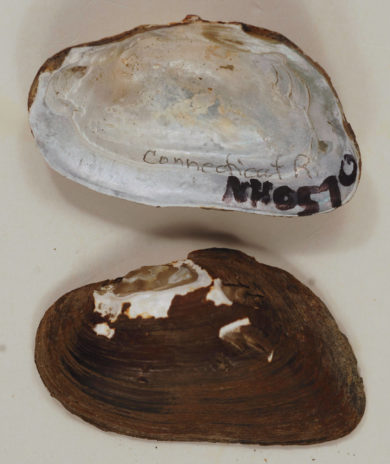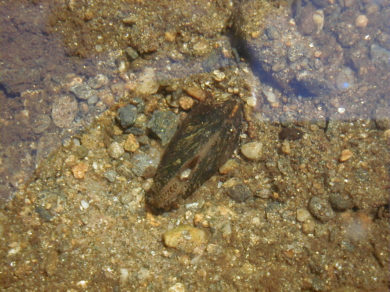 The Dwarf Wedgemussel is the only freshwater mussel listed under the Federal Endangered Species Act that is found in Vermont. Threats include pollution, habitat degradation, dams, and reductions in host fish ranges. Its lifespan is relatively short compared to other freshwater mussels – about 12 years.
The Dwarf Wedgemussel is the only freshwater mussel listed under the Federal Endangered Species Act that is found in Vermont. Threats include pollution, habitat degradation, dams, and reductions in host fish ranges. Its lifespan is relatively short compared to other freshwater mussels – about 12 years.
Key Characteristics
- Size: 1 to 1.5 inches.
- Shape: Somewhat triangular or “wedge-shaped” at the posterior end, which is sometimes pointed. Adults are small and often exhibit much more shell erosion than comparably sized juveniles of other species.
- Periostracum: Color yellowish-brown, olive-brown, or blackish-brown. Shell rays present but sparse, particularly in adults.
- Lateral Teeth: Present but thin. Two on the right valve and one on the left valve, which is the opposite of all other North American freshwater mussel species that possess lateral teeth
- Pseudocardinal Teeth: Present. Two on the left valve and one on the right valve.
- Nacre: Color usually bluish-white and somewhat iridescent along the posterior margin, sometimes with greenish or yellowish markings toward the beak cavity.
- Similar Species: Creeper, Brook Floater, Triangle Floater
Conservation Status
This is the only federally endangered freshwater mussel in New England. Historically, it was found in nearly 70 locations in 15 watersheds along the Atlantic seaboard, but its range and population sizes have dramatically decreased in the last century. Only 54 populations remain globally; 41 of these are estimated to contain fewer than 50 individuals. Recent surveys in the Ashuelot and Connecticut Rivers indicate an apparent decline and therefore further reason for concern.
- State and Global Rank: S1 (critically imperiled) G1G2 (critically imperiled to imperiled)
- Vermont Wildlife Action Plan: Species of Greatest Conservation Need
- Vermont Endangered Species Law: Endangered
- U.S. Endangered Species Act: Endangered
- IUCN Red List: Vulnerable
Habitat
A large river species, it is found in stable mud, silty sand, sand, or gravel where the current is sufficient to keep the substrate free of surficial silt. Prefers stable substrates in slow or moderate currents. It is often found near the banks among roots.
Host Species
Fish hosts in Vermont include the Tessellated Darter (Etheostoma olmstedi) and Slimy Sculpin (Cottus cognatus). Storm-assisted dispersal could be an important dispersal mechanism for this species too.
Range
Only found in the Connecticut River basin on the mainstem of the Connecticut River, and slightly upstream into some larger tributaries. Historically found from Bloomfield to Brattleboro. More recently known from Hartland to Springfield, and from Guildhall to Lunenburg.
More Information
- Encyclopedia of Life
- NatureServe
- Musselp
- New Hampshire species page and map
- USFWS species profile
- iNaturalist species page







